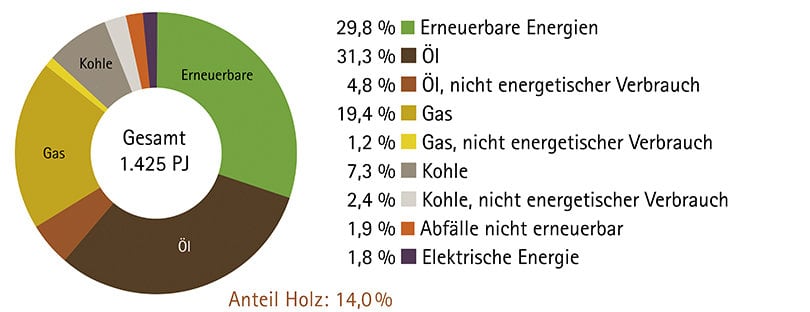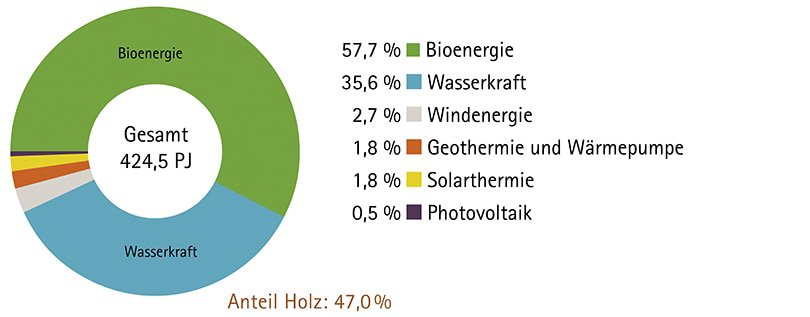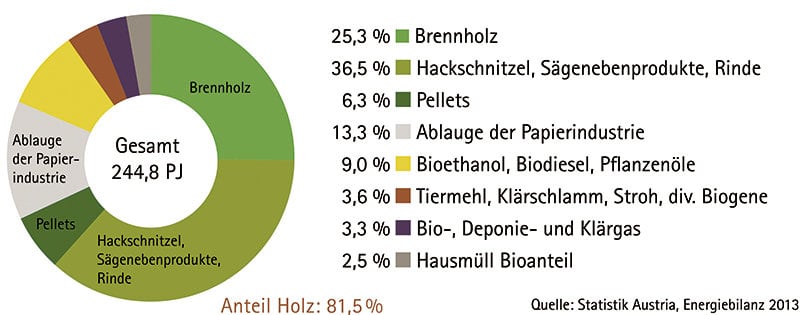From the outside, pellets are completely unspectacular, but their enormous power is hidden inside: With an energy density of around 4,8 kWh / kg (17.000 kJ / kg), two tons of pellets correspond to around 1.000 liters of heating oil. It is not for nothing that the small sawdust pressings are considered to be the bearers of hope for the environmentally friendly energy future. The goal has been clear since the 2015 Paris Climate Agreement at the latest: While fossil fuels will have to be banned as an energy source over the next few decades and the currently rising energy consumption should be slowed down, the remaining gap must be closed almost entirely with renewable energies. Biomass in particular traditionally plays an important role in Austria: the proportion of bioenergy with firewood, wood chips, pellets and the like in renewable energies is a proud 57,7 percent - well ahead of hydropower. Biogenic energy sources are also ahead of the curve when it comes to heating domestic apartments: With a market share of 33 percent, they have been well ahead of natural gas (2012 percent), heating oil (24 percent), district heating (23 percent), electricity (12,5, 3,9 percent) as well as solar heat and heat pumps (together 3,4 percent).
Pellets in numbers
Even 1997 was Austria's pellet production capacity at 5.000 tonnes, since then production and use have risen sharply: 2015 has already produced one million tonnes of pellets in this country, 850.000 tonnes consumed. In the same year each Austrian consumed on average about 100 kilograms of pellets for heating purposes and is on par with Denmark, just behind Sweden (120 kg). But the balance is not quite that simple: Austria has always been pellet net exporter: 2015 555.000 tons went abroad, 369.000 tons were imported mainly from Romania, Germany and the Czech Republic.
Pellets are produced in Austria as a by-product of the wood industry and are the result of the utilization of sawdust and wood shavings, which in this way are refined into a high-quality energy source. Sawdust and wood shavings are automatically produced in large quantities when cutting / processing wood.
The success of biomass in recent years can be explained in a simplified way, apart from the ecological idea: pellets in particular are a clean, future-proof and, above all, inexpensive, reasonably priced alternative to heating oil and gas. 1997 could only use 425 Austrian pellets for heating 2014 pellet boilers are counted.
The use of the environmentally friendly heating alternative could also grow even faster, but: "Pellet production is likely to develop in the future, as in the past, approximately parallel to domestic consumption. This is, among other things, a function of how serious the energy transition is taken, at what speed, for example, the currently around 700.000 oil heating systems in Austria are being replaced, "says Christian Rakos, Managing Director of the pro-Pellets Austria interest group.
Electricity from pellets
But the small pellets also have even greater potential. Currently, technical solutions are being used to generate electricity from sawmill by-products. What is meant here is the combined heat and power in the small power range, which allows a simultaneous power and heat production. There is still a need for research and development here, but the first heating models are already on the market. And above all, they will offer one thing in the future: more energy autonomy for domestic households. ÖkoFen recently commissioned the first "large" pellet heating system "Pellematic e-max" from a customer.
Prejudices refuted
All well and good - if not two prejudices would cloud the green future. Prejudice one: Excessive use of wood is counterproductive, even harmful to the environment. "Not forest use is the threat to the forest. The real threat to native forests is climate change. We have to use the resource forest sustainably energetically, in order to ensure the existence of the forests in the long term ", counter Rakos. And: "For the past fifty years, the Austrian Forest Inventory (ÖWI) has been assessing the condition and changes in the Austrian forest. Its data provide information on its stability and are used as the basis for decisions in forest and environmental policy. The stock of wood, studies show, has been increasing steadily since the 1960s. Conservation and the increased use of wood as a raw material and source of energy need not contradict one another. "And the data of the ÖWI actually shows a clear picture: Austria has an area of 47,6 percent with about four million hectares of forest - with an annual increase of 3.040 hectares. Rakos: "In Austria, pellets are produced exclusively from sawdust and shavings. For pellets, not a single tree is felled. In Europe, only about 2 / 3 of annually renewable wood is harvested - the wood in the forest is constantly growing. "
Key regionality
Prejudice two: Through imports of pellets over long distances, the ecological sense is counteracted. Skeptics say that pellets are a renewable raw material, but CO2 is also emitted during processing and transport. The example of the Welser pellet manufacturer Sturmberger disproves this quite clearly for domestic pellets: Due to the fact that heat is only sourced and supplied locally for sawdust drying from a waste incineration plant and energy-efficiently produced, an 98,9-percent CO2 reduction compared to oil heating systems can be achieved. Conclusion: The keyword in pellet use is regionality.
Economic factor pellets
And this regionality also shows another major economic advantage: The decentralized expansion of renewable energies generates tax revenues in the municipalities, creates jobs and thus improves purchasing power in the region. In Germany, heat from renewable sources generated about one billion euros in 2012. For Austria, there is a study by the Austrian Energy Agency, which quantifies the direct regional employment through the use of energy from biomass. Compared to other heating systems, especially those based on oil and natural gas, the figures for pellets - 123 or 217 labor force hours per TJ, if the pelleting plant is also in the region - give an impressive picture of regional employment intensity.
Advantages and disadvantages
- Pellets are the renewable energy source that meets the heat demand of the household. Small-scale electricity production still lacks competitive technologies.
- Pellet heaters offer maximum heating comfort and reliability.
- Pellets are a standardized, domestic natural product with a high calorific value and clean combustion.
- Pellets need little space and can be stored in the adapted old oil storage room.
- Pellet firings can also be placed in the living room (pellet stoves or pellet central heating stoves) and create a living atmosphere through the firelight.
- Pellets are not only much cheaper than heating oil and gas, but also more stable in price.
- Pellet heating is promoted in most federal states as well as by the climate and energy fund.
- Pellets are a climate-friendly fuel because they release only as much CO2 as trees have absorbed when growing from the air.
- Wood pellets stand for domestic added value and jobs and thus create a good social and environmental conscience.
- Compared to oil and gas heaters higher investment costs in the system.
Gross domestic consumption of energy, renewable energy and biomass
(Statistics Austria, Energy Balance 2013)



Photo / Video: Shutterstock.




Still, I'm heating with oil. Pellets would be better ????